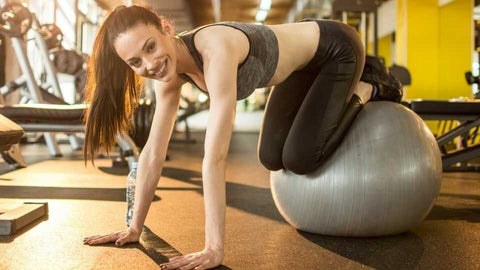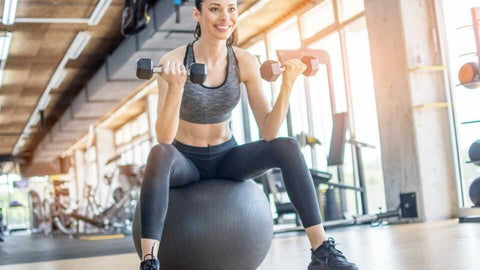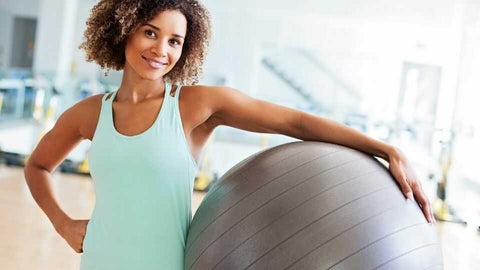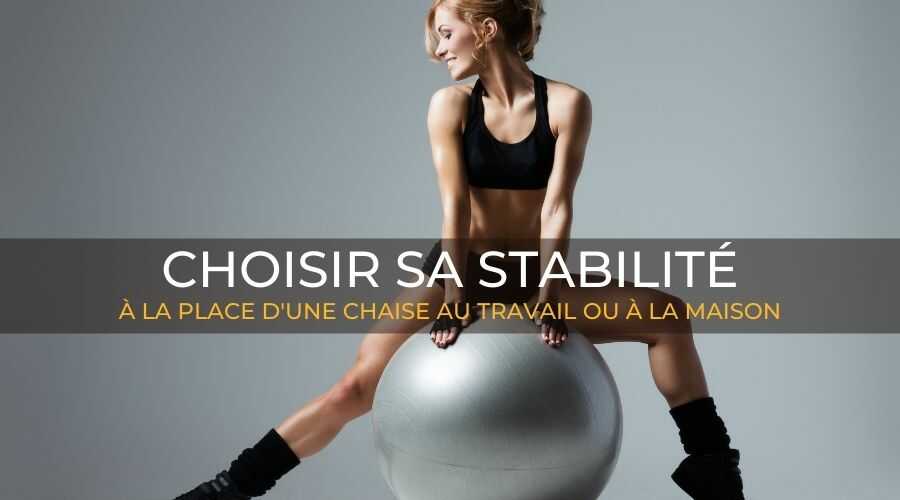The Swiss Ball, also called a gym ball, yoya ball or stability ball, has been around for a long time, since 1963 to be exact.
It was invented by Aquilino Cosani, an Italian plastic manufacturer.
Today, Swiss balls are in almost every gym and it is not uncommon to see them instead of a chair at work or at home.
But with a variety of gym ball choices, buying one can be daunting.
So how do you choose a Swiss Ball from this variety?
The two most important criteria for choosing the right Swiss Ball (also known as a gym ball, fitness ball, and exercise ball) are the size and material of the ball.
The size of the Swiss Ball or stability ball is important.
First of all, Swiss Balls often come in several standard sizes 45cm, 55cm, 65cm and 75cm in diameter.
The most common method to choose the right size ball for a person is to sit on it.
Sit on a properly inflated Swiss Ball with your feet flat on the floor and your knees should be just below your thigh. If your knees are higher than your thigh, the ball is too small for you.
It is possible to inflate or deflate the ball a little more or a little less than its recommended size, but not too much.
-
If it is overinflated, you run the risk of the balloon bursting at the worst possible moment.
-
If it is underinflated, it becomes less wobbly and loses its "unstable surface" properties that make the ball a great stability exercise tool. An underinflated ball also presses on the back of your thigh when you sit. This can restrict blood flow if you sit for long periods of time.

If you intend to use the ball for exercises other than sitting, you should test the size of the ball to see if your posture or form is correct for those particular exercises.
The material matters too.
One thing you'll notice almost immediately is that an inexpensive stability ball tends to be quite stretchy.
Avoid these materials if possible, as their stretchy properties make it harder to adjust the size of a ball to your height. Sitting on a 65cm ball can quickly reduce it to the height of a regular 55cm ball.
Stretchy materials also tend not to be burst proof.
Anti-burst is a common selling feature when you buy exercise balls. But what does it mean?
Well, that doesn't mean your balloon will never break or puncture.
What this means is that if you get a puncture and are sitting on it, the balloon will slowly deflate, giving you time to get off or, failing that, fall more gently to the ground.
When a regular gym ball is punctured, it bursts like a balloon, which is very quick and can cause injury.
Anti-burst gym ball material tends to be more rigid, but not all rigid materials are anti-burst. A good gym ball should last you for several years.
What size gym ball is right for me?
Exercise balls come in different sizes, depending on your height, leg length, and whether you want to use it primarily for exercise or as a posture seat.
The correct size of the exercise ball is essential to avoid causing pain or injury.
For example, your hips should be above your knees to allow for the usual curve in your lower back when you sit on your exercise ball.
Recommended exercise ball size:
Exercise Ball Diameter - Person Height
-
45 cm - less than 145 cm
-
55 cm -140 to 165 cm
-
65 cm - 165 to 185 cm
-
75 cm - 185 cm to 195 cm
-
85 cm - over 195 cm

Is Sitting on an Exercise Ball Good for You?
You may not realize it, but most of us have poor posture.
Unfortunately, this leads to long-term wear and tear on the spine. When used as a chair, the Swiss Ball encourages you to adjust your pelvis while sitting.
In addition to creating better circulation in your spine, the gentle bounces and balance reactions will improve the strength of the vital postural muscles in your back.
How to use an exercise ball as a chair?
The key to sitting safely on an exercise ball is having the proper height.
You need a ball that lifts your sit bones just above your knee, so that the angle of your thighs slopes slightly downward from your groin to your knees.
Otherwise, your lower back will curve in the wrong direction, which puts you at high risk of developing lower back pain.
But, once you have solved this ball height issue, an exercise ball can be successfully used as an office chair to stimulate your postural muscles but not for more than two hours at a time.
This automatic muscle activation saves you time exercising those important back stability muscles, while giving you a pain-free office chair.
Is an exercise ball good for lower back pain?
Exercise ball and back pain.
Back pain is often the result of weak stabilizing muscles that support your joints. Without strong support, your joints collapse.
Your bony skeleton doesn't stand up on its own. Bones are held upright by efficient supporting muscles that work at every joint in your body.
Research has shown that pain causes these supporting muscles (called "stabilizers" or "core stability muscles") to stop working.
Research on people with lower back pain has shown that these muscles stop working whenever you have back pain.
Worse still, in most cases, these muscles don't automatically start working again when the pain goes away. They have to be deliberately restarted by your brain.
Your exercise ball is an unstable surface. When you sit or exercise on one of these balls, your body automatically engages your natural balance responses.
One of the essential components of your balance response system is the activation of your core stabilizing muscles.
With repeated use for just a few days, your stabilizer muscles will automatically start working again in most cases.
So, can using an exercise ball help with lower back pain?
In most cases, YES. But, in some cases, it can make your lower back pain worse. Please consult your back pain physiotherapist for a personalized assessment and back care plan.
There are several ways to reactivate your core stability muscles. One of the most effective is to use a Physio exercise ball. In general, a few simple exercises can often automatically restart these stabilizing muscles.
Your physiotherapist has undergone special training in techniques for reactivating these stabilising muscles. For further advice, please contact your physiotherapist.
Tips for inflating exercise balls.
You can use any air pump to inflate your exercise ball.
Air mattress pumps, reverse vacuums, and air compressors are the most efficient. Hand pumps can be used but are less efficient.
Here are some tips :
-
Do not over-inflate your balloon if it is below 20 degrees Celsius. Warm it to room temperature (20 degrees or more) before inflating.
-
The correct size of an exercise ball is determined by diameter rather than pressure. Do not inflate the ball beyond the recommended size.
-
Initially inflate the balloon to about 80% of its diameter. Wait another 24 hours before inflating it to the recommended size. You should avoid using the balloon within the first 24 hours.
-
Place two boxes at the desired distance apart using a tape measure on the floor to gauge the correct size. To test, roll your exercise ball between the boxes. When each end of the ball touches both boxes, you have the correct size.
How to choose a gym ball?
How to find the right exercise ball size for you?
Exercise balls, or stability balls, are useful for workouts or as a chair. They help build core stability for virtually any exercise.
Finding the right size exercise ball for your body and goal is essential. Ensuring that your exercise ball is the right size and firmness will help you get the best workout possible. 
Choose an exercise ball that is sized in proportion to your height. You should be able to sit on your ball with your legs at a 90-degree angle or slightly more, but not less.
Your thighs should be parallel to the floor or slightly tilted downward.
With your feet flat on the floor and your spine straight (not leaning forward, back, or to the side), your knees should be level with or slightly lower than your hips.
Look for a durable, thick, and highly burst-resistant balloon. Check the balloon's weight rating before purchasing.
Choosing an exercise ball that is appropriate for your weight is also important. If you are heavy for your height, you may need a larger ball to keep your knees and legs at the right angle.
How to use an exercise ball?
Inflating the exercise ball.
For most exercises, you want the surface of the ball to be a little softer. When you sit on the exercise ball, your body weight should create a little cushion.
This provides greater stability, but more importantly, it allows you to sit evenly on the ball. Practicing with good alignment is essential.
The more inflated the ball, the harder it will be to balance on it, whether sitting or in any other position. Inflation is therefore a matter of preference, but avoid inflating the ball to the point where it risks bursting.
Your ball may need to be reinflated from time to time. Most come with a small pump for this purpose.
What to do with your exercise ball?
Exercise balls are very versatile and are an inexpensive and easy-to-use home workout tool.
Exercise balls are especially helpful for improving core strength and stability.
How much should I inflate my 65cm exercise ball?
Instructions for a 65cm exercise ball.
No matter your fitness level, an exercise ball, also called a stability ball, fitness ball or Swiss ball, can add an element of fun to your workouts.
When used correctly, the ball allows you to perform a number of exercises to improve your balance, muscular and core strength, and flexibility.
The 65cm exercise ball is one of the largest sizes available. If you've never trained with this size before, it's not difficult to get started.
Simply follow the manufacturer's instructions and assembly guidelines.

Exercise balls are inflated based on their size, not air pressure. A 26-inch ball, when fully inflated, measures 25 inches.
To ensure your ball measures this height after inflating, make a reference mark on the wall, 60cm from the ground. Balls come with a plug installed and an adapter that attaches to most bike pumps.
We give you the following advice :
-
Allow the balloon to warm to room temperature before inflating.
-
Remove the cap, start pumping, stop when the balloon is 10 cm less than its maximum height 53 cm
-
Replace the cap. After 24 hours, complete the inflation process.
-
As you pump, check the height against your reference mark, stop when it has reached a height of 65 cm and insert the stopper.
Check the fit:
-
Your height determines the best ball size for your needs. If you are between 6'1" and 6'1", the 26" ball is the right size.
-
To be sure, sit upright on the ball with your feet flat on the floor. If your hips and knees are bent at 90 degrees, the ball is right for you.
Safety and precautions:
-
Work with your exercise ball in an area with plenty of free space, away from walls, other fitness equipment, and furniture. The floor surface should be flat, smooth, and free of any small or sharp objects.
-
Keep the balloon away from direct heat sources, such as space heaters or fireplaces, and avoid exposing your balloon to long periods of extreme sunlight.
-
Before exercising, remove rings, watches, and any sharp objects that could puncture the ball. Use good form and posture when exercising.
-
Avoid bouncing on the ball when doing exercises that require you to bend or twist your torso, as you could injure your back.
Ball maintenance:
-
With proper care and maintenance, exercise balls can perform reliably and last a long time. Clean the ball often with a mild detergent, warm water, and a soft cloth.
-
Avoid using abrasive cleaners or harsh chemicals, as they may damage the surface of your ball. Inspect the ball often for holes or deep scratches.
-
If your ball is punctured, replace it rather than repair it. To prevent the air inside the ball from expanding or contracting, store it in a safe place where it is neither too hot nor too cold.
Do's and Don'ts of Exercising with the Gym Ball.
-
Perform a short, light aerobic warm-up and check the ball for damage before beginning your exercise session.
-
Maintain good posture and spinal alignment to minimize the risk of back injuries. Exercises are most effective if you keep your core muscles engaged throughout the session and perform slow, controlled movements throughout the range of motion.
-
Rest 60 seconds between sets and 90 seconds between exercises. If you have balance problems, place the ball against a wall.
-
Avoid muscle imbalances by performing exercises that work the front and back of your body.
We have spent a lot of time to bring you the most comprehensive article about what ab exercises to do with a swiss ball, we hope you enjoyed learning about it.
Do not hesitate to subscribe to the private club, you will also receive our complete book as a gift on the best way to structure your fitness training, you will receive an email in advance when an article appears on our site leboxdufitness.com
Also feel free to check out our store which offers the best fitness, bodybuilding and fitness equipment.
Did you like this article and it helped you to know which abdominal exercises with a swiss ball. Leave me in the comments, if you were already aware of these concepts and what is your experience on the subject.
If you want to find other Fitness and Wellness articles, take a look at the fitness shop review and best seller sections of the store, you will find plenty of products to use at home.
And if you want to know more about our sportswear for your fitness sessions, building muscle or losing fat, don't hesitate to consult the fitness clothing collection .
You can download my complete fitness guide “ The essentials for a body in top shape ” for free and subscribe to our Facebook page and our Instagram account .
Thank you for reading, I am personally responding to the comment.
Looking forward to corresponding with you!


















